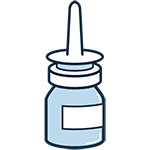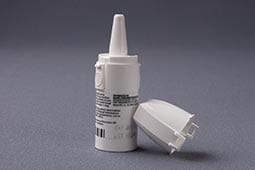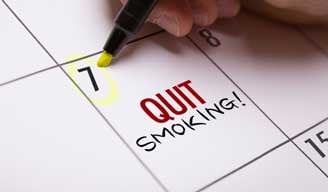How to Use the Nicotine Nasal Spray
There are seven medicines approved by the Food and Drug Administration (FDA) to help you quit. They work in different ways. All have been shown to be safe and effective for adults who smoke cigarettes.
These quit-smoking medicines include nicotine replacement medicines (the nicotine patch, lozenge, gum, oral inhaler, and nasal spray) and pill medicines (varenicline and bupropion SR).
Some other strategies, with or without medicines, can help you quit as well.

Nicotine nasal spray comes in a hand-held sprayer bottle. You need a prescription for it. You use one spray in each nostril frequently throughout the day. The medicine is not inhaled. The nicotine is absorbed mostly in your nose. It is usually prescribed to people with severe nicotine addiction. Your doctor or pharmacist can give you detailed instructions on how to use it. They can also help you set and adjust your dose.
- You’ll need a prescription from a prescribing healthcare provider for the nicotine nasal spray.
- To use the nasal spray, first blow your nose to ensure it is clear. Tilt your head back slightly. Put the tip of the bottle into your nostril – as far as you feel comfortable. Breathe through your mouth. Then spray once in each nostril. Do not sniff, swallow, or inhale while spraying. If your nose runs, gently sniff to keep the medicine in your nose, where it will be absorbed. Wait at least 2-3 minutes before blowing your nose. Put the cap back on the nasal spray and store out of reach of children and pets. One bottle of nasal spray typically delivers about 200 sprays.
- During the first week, most people experience a hot, peppery feeling in the back of the throat or nose, as well as sneezing, coughing, watery eyes, or runny nose when using the nasal spray. These symptoms should lessen after a week of regular use. Contact your doctor or other healthcare provider if the symptoms are particularly bothersome or do not go away.
- Use the nicotine nasal spray often enough, as directed by your doctor or other healthcare provider, to help control cravings for cigarettes. One dose of nasal spray is 2 sprays (one in each nostril). To ensure that your body gets enough nicotine to ease your withdrawal symptoms, it is best to use at least 8 doses per day for the first 6 weeks. Do not use more than 40 doses per day. People typically start with 1 to 2 doses per hour. Your doctor can help you set and adjust your dose and can talk about gradually reducing your dose when you are ready.
- If the bottle breaks or leaks, wear rubber gloves to wipe up the liquid with a paper towel and to wash surfaces thoroughly. Do not let the liquid come in contact with your skin, mouth, or eyes. If it does, rinse with plain water immediately. Nicotine overdose can occur when nicotine is absorbed through the skin.
- Keep out of reach of children and pets. Nicotine nasal spray may have enough nicotine to make children and pets sick. When you are done using the nasal spray, be sure to put the cap back on the bottle and store it out of reach of children and pets. When you finish using a spray bottle, immediately throw it in the trash. In case of accidental use or ingestion, contact a Poison Control Center right away (1-800-222-1222).
- Quitting smoking may make some people depressed or anxious, whether quitting with medication or not. Get help if you have feelings of depression or anxiety that last for more than two weeks or that get worse.
- Learn more about the nicotine nasal spray
- Consider combining the nicotine nasal spray with nicotine patches if you continue to have withdrawal symptoms. Patches can provide a steady level of nicotine in the body to help lessen withdrawal, while the nasal spray can be used to more quickly relieve cravings as they happen.
- If you have strong cravings while using the nicotine nasal spray, make sure you are using it often enough. It’s best to take at least 8 doses a day (one dose = two sprays, one in each nostril), and you can take up to 5 doses per hour and up to 40 doses per day.
- What if I slip up and smoke while using the nicotine nasal spray? It is important not to smoke while using the nicotine nasal spray to reduce the risk of nicotine overdose. If you slip up and have a cigarette during your quit attempt, you can still continue your quit attempt, but consider talking with your healthcare provider about dosing changes. Throw away your cigarettes and get back on track. Keep using the nasal spray as directed.
- What if the side effects are too much for me? Common side effects from using the nasal spray include a hot peppery feeling in the back of the throat or nose, sneezing, coughing, watery eyes, or runny nose. These should go away after about a week of regular use of the nasal spray. If they do not, or if they are particularly bothersome, contact your healthcare provider, and consider using another one of the FDA-approved quit-smoking medicines discussed on this page.
- What if I feel like I can’t stop using the nicotine nasal spray? Nicotine nasal spray works quickly and can be addictive, like cigarettes. So, it is important to carefully follow the dosing instructions from your healthcare provider. If you feel like you need to use more than the recommended dose or you have been using it for more than 3 months and need help stopping, contact your healthcare provider for help.
- For best results, use the nicotine nasal spray as part of a program that includes coaching support. Talk with your healthcare provider and connect with your state tobacco quitline (1-800-QUIT-NOW) for help.
- Can be used regularly and when you feel withdrawal symptoms or urges coming on.
- Delivers nicotine most rapidly of all nicotine replacement medicines (NRTs).
- Can be used with the patch to deal with breakthrough urges.
- You control how often you use it, so you won’t get more nicotine than you want.
- Usually takes several days to get used to nose irritation.
- You have to remember to use it regularly and often.
- Some people don’t like having to spray medicine into their nose.
- It’s more addictive than other forms of NRT but still safer and less addictive than smoking cigarettes.
- May be visible to people around you when using.
- Requires a prescription.
Possible Side Effects (and what you can do about them):
- Nose and throat irritation; hot, peppery, burning feeling (very common, but may lessen with continued use).
- Tearing, runny nose, sneezing, or cough (often people get used to these. Talk to your doctor if they continue to bother you).
- Headache (Consider waiting longer between doses and talk with your doctor).
Nasal Spray Precautions (If any of these apply to you, talk to your doctor or other healthcare provider before starting to use spray.):
- A heart attack in the last two weeks.
- A serious heart rhythm problem.
- Pain in your heart (angina) that is serious or getting worse.
- Problems in your nose or sinuses.
- Severe breathing problems like asthma.
- Could be pregnant or are breastfeeding.
- Less than 18 years old.
More precautions and general information are available about the nasal spray.
- You’ll need a prescription from a prescribing healthcare provider for the nicotine nasal spray.
- To use the nasal spray, first blow your nose to ensure it is clear. Tilt your head back slightly. Put the tip of the bottle into your nostril – as far as you feel comfortable. Breathe through your mouth. Then spray once in each nostril. Do not sniff, swallow, or inhale while spraying. If your nose runs, gently sniff to keep the medicine in your nose, where it will be absorbed. Wait at least 2-3 minutes before blowing your nose. Put the cap back on the nasal spray and store out of reach of children and pets. One bottle of nasal spray typically delivers about 200 sprays.
- During the first week, most people experience a hot, peppery feeling in the back of the throat or nose, as well as sneezing, coughing, watery eyes, or runny nose when using the nasal spray. These symptoms should lessen after a week of regular use. Contact your doctor or other healthcare provider if the symptoms are particularly bothersome or do not go away.
- Use the nicotine nasal spray often enough, as directed by your doctor or other healthcare provider, to help control cravings for cigarettes. One dose of nasal spray is 2 sprays (one in each nostril). To ensure that your body gets enough nicotine to ease your withdrawal symptoms, it is best to use at least 8 doses per day for the first 6 weeks. Do not use more than 40 doses per day. People typically start with 1 to 2 doses per hour. Your doctor can help you set and adjust your dose and can talk about gradually reducing your dose when you are ready.
- If the bottle breaks or leaks, wear rubber gloves to wipe up the liquid with a paper towel and to wash surfaces thoroughly. Do not let the liquid come in contact with your skin, mouth, or eyes. If it does, rinse with plain water immediately. Nicotine overdose can occur when nicotine is absorbed through the skin.
- Keep out of reach of children and pets. Nicotine nasal spray may have enough nicotine to make children and pets sick. When you are done using the nasal spray, be sure to put the cap back on the bottle and store it out of reach of children and pets. When you finish using a spray bottle, immediately throw it in the trash. In case of accidental use or ingestion, contact a Poison Control Center right away (1-800-222-1222).
- Learn more about the nicotine nasal sprayexternal icon, including side effects and precautions.
For more help using medicines to quit smoking, call 1-800-QUIT-NOW or visit CDC.gov/quit. Talk with your healthcare provider about the best medicine for you. Using medicine together with behavioral counseling gives you the best chance of quitting smoking.

- Consider combining the nicotine nasal spray with nicotine patches if you continue to have withdrawal symptoms. Patches can provide a steady level of nicotine in the body to help lessen withdrawal, while the nasal spray can be used to more quickly relieve cravings as they happen.
- If you have strong cravings while using the nicotine nasal spray, make sure you are using it often enough. It’s best to take at least 8 doses a day (one dose = two sprays, one in each nostril), and you can take up to 5 doses per hour and up to 40 doses per day.
- What if I slip up and smoke while using the nicotine nasal spray? It is important not to smoke while using the nicotine nasal spray to reduce the risk of nicotine overdose. If you slip up and have a cigarette during your quit attempt, you can still continue your quit attempt, but consider talking with your healthcare provider about dosing changes. Throw away your cigarettes and get back on track. Keep using the nasal spray as directed.
- What if the side effects are too much for me? Common side effects from using the nasal spray include a hot peppery feeling in the back of the throat or nose, sneezing, coughing, watery eyes, or runny nose. These should go away after about a week of regular use of the nasal spray. If they do not, or if they are particularly bothersome, contact your healthcare provider, and consider using another one of the FDA-approved quit-smoking medicines discussed on this page.
- What if I feel like I can’t stop using the nicotine nasal spray? Nicotine nasal spray works quickly and can be addictive, like cigarettes. So, it is important to carefully follow the dosing instructions from your healthcare provider. If you feel like you need to use more than the recommended dose or you have been using it for more than 3 months and need help stopping, contact your healthcare provider for help.
- For best results, use the nicotine nasal spray as part of a program that includes coaching support. Talk with your healthcare provider and connect with your state tobacco quitline (1-800-QUIT-NOW) for help.


